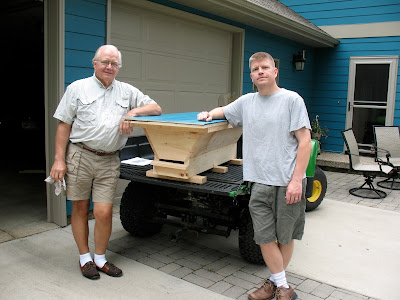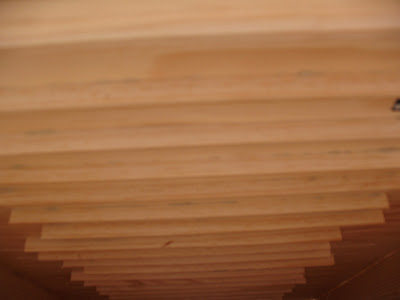 |
| Kenyan top-bar hive carpenters and their finished product. |
It is meant to emulate a hollowed-out log hive with bars across the top, presumably used in Kenya and the surrounding areas.
 |
| Front-ish view. |
 |
| Side view. |
 |
| A closer view of the entrance and the landing board. |
I entered into the Nicollet County Fair last summer and received a blue ribbon and a $2 - $3 prize. I was so drenched in fame and fortune that I could no longer appear in public. However, that's a story for another post...
 |
| A view of the underside of the top cover. |
 |
| The cover is off, and you can see the top surface of the cover. That the cover surface is suspiciously like the house's siding is purely coincidental, of course. |
The following two pictures show the hive with the top cover (the blue-colored cover) off. You can see four of the bars standing upright. This shows you the underside of the bars. A thin wood strip is embedded into the bottom of the bars. The goal is that these will prompt the bees to build comb on each bar's underside there and there only.
You can also see into the hive itself. The large, empty cavity will be eventually filled with parallel strips of comb growing down from the bars arranged across the top.
Below was my attempt to put the camera into the hive and take a picture of the underside of the bars. This is what the bees would "see" from within the hive. They would ideally see the rows of low points and build comb down from each wooden strip.
 |
| A view from inside the hive, looking up at the top bars. |
In case the pictures are difficult to interpret, the main part of the hive is like a large, trapezoidal, feeding or watering trough. This shape keeps the bees from attaching comb to the sides of the hive. The bars are placed across the top. They fit together with no gap between the bars. On the underside of the bars, a thin strip of wood was glued in. Think of a popsicle stick, but larger and a bit thicker. The idea with this "starter strip" is that the bees will use these to guide their comb production. Hence, the comb will be nicely parallel and allow me to inspect the hive without destroying "cross comb" pieces.
I haven't yet put bees into it, as I heard that bees cannot over-winter in MN in a top-bar hive. However, another blog that I follow (http://topbarbeesmn.blogspot.com) and blogs mentioned by the author give me hope that I might be able to get bees to survive the winter in the Kenyan top-bar hive.
My plan now is to place it out in the prairie next spring. If my two current hives survive the winter, they may be likely to swarm next spring/summer. If I can either catch a swarm to install it into the Kenyan top-bar hive or bait a swarm into it, I can get going with that hive.


No comments:
Post a Comment